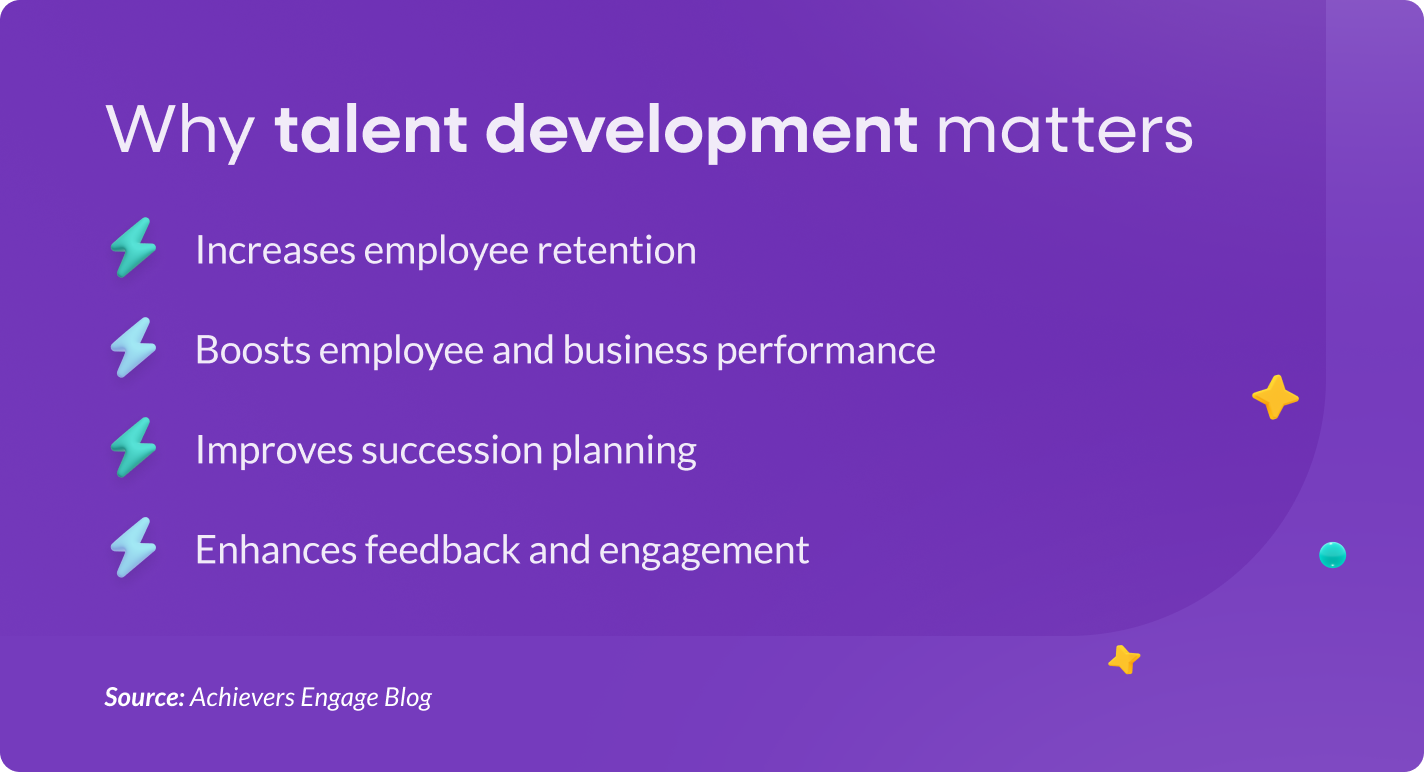Table of contents
Great employees are an organization’s most valuable asset — yet talent development often takes a back seat in the day-to-day responsibilities of employers. The reality is that talent development is an important business practice that not only benefits employees, but employers and organizations.
In fact, insights from Achievers 2024 Engagement and Retention Report found internal opportunities for growth and development had the biggest non-monetary impact on employee retention.
When employers invest in their team and their potential, it sends a clear message to employees that they’re valued and have something unique to bring to the table. Those feelings of belonging can influence positive behaviors that help drive business goals. Ultimately, it’s a win-win for everyone. It just takes the right program and strategy.
But great employee development programs don’t develop overnight. They need defined goals and strong two-way communication. Achievers is ready to help you make the most of your best players, with clear strategies to bring your talent development plans to life.
What is talent development?
Talent development is all about helping your employees learn, grow, and thrive. It includes the programs and activities that not only meet your company’s needs but also align with your team members’ goals and interests. And it’s more than just offering a training session here and there. Talent development means giving every employee a clear path to building their skills, growing within the company, and reaching their professional dreams.
It also calls for leaders and HR pros who know how to spot potential and nurture it. As part of a modern employee value proposition (EVP), talent development shows your team that your company truly cares about them as individuals and is committed to their success.

Why talent development matters
Talent development should be a big part of every company’s business strategy. When done right, it empowers employees to grow and thrive while helping organizations encourage the behaviors that will lead to better business outcomes. Here’s why investing in talent development matters:
Increases employee retention
If you want to create the best products and services, you need to keep the best talent in your organization. That’s where talent development can help. In 2024, career progression was the second most important reason employees considered leaving their current job after compensation, according to the Engagement and Retention Report from Achievers Workforce Institute (AWI).
When employees don’t feel like leadership is invested in their growth and success, they’re more likely to look for opportunities elsewhere. Creating talent development opportunities keeps your best people right where they are and inspired to do their best work.
Boosts employee and business performance
It’s a simple concept: empower employees with everything they need to succeed and reap the rewards. Employees can’t perform well if they don’t have the skills and knowledge they need to succeed in their roles. When training resources and opportunities for further growth are available, team members are more likely to accomplish or even exceed organizational objectives.
Improves succession planning
Your best employees have insights and skills that are key to your success. But when they feel stuck or see no clear path forward, they may decide to leave, taking that expertise with them. That’s where succession planning becomes essential. It guarantees your best talent sees opportunities to grow and contributes at a higher level.
A strong talent development program helps address this by identifying employees ready to step into advanced roles and providing them with the tools and training to thrive. It’s not just about passing the torch; it’s about showing your team their future is bright within your organization.
Enhances feedback and engagement
All team members want feedback, but few organizations provide it in ways employees find meaningful. When feedback is prioritized in an organization, engagement increases.
A strong talent development program with a focus on coaching can lead to more engagement across an organization. And when employees are engaged, they’re more productive and inspired to go above and beyond.
Questions to ask to overcome talent development challenges
Investing in talent development is invaluable to an organization, but it’s not without its challenges. Here are some potential issues that organizations may face when creating a talent development program and how your company can address them:
Does your talent development program align with your organizational needs?
Is your business providing sales training courses when it really needs more field repair technicians? Or is it prioritizing enhanced customer service without predicting the need to keep upskilling its software development team? A talent development program must be able to nurture the talent needed to help your business succeed.
Is your program personalized?
Every employee is different, from the skills they bring to your company to their preferred learning styles. A talent development program that treats employees if they’re the exact same is doomed to fail. Personalize your talent development offerings to match team members’ needs, goals, and abilities. If you’re not sure where to start, reach out to employees with an employee survey.
Is your program easy to access and administer?
Hybrid and remote work are becoming the new norm for many organizations, bringing with it new ways to achieve organizational priorities across the board — from engaging remote employees to developing talent. If employees can’t access your company’s talent development resources whenever and wherever they choose, they’re less likely to take advantage of them.
Do you have a talent development manager in place?
A talent development manager is the HR professional who oversees your company’s talent development program. Their goal is to help team members grow in ways that improve your organizational culture, contribute to both personal and organizational success, and boost employee retention. They partner with leaders in HR and throughout the organization on projects ranging from recruitment to performance improvement.
Qualifications for this position typically include education or experience related to human resources, organizational development, or business. Strong skills in communication, problem-solving, and data analysis are also useful. They should feel comfortable completing leadership tasks like developing learning activities, instructing team members, and providing encouragement and motivation.
6 actionable talent development strategies
Ready to improve talent development at your organization? We’ve got six strategies for building a results-driven program that fits your business and its employees.
1. Find existing skill gaps and learn how to fill them
Consider your company’s current needs and long-term goals. What roles and skills are needed to achieve them? Do you currently have enough team members for those roles, and do they have the right experience? If not, you’ve just identified a skills gap. When it comes to filling skill gaps, recruitment is an obvious choice, but it’s also important to look within your own team. With additional education, they can meet the challenge while bringing institutional knowledge and engagement that external candidates may lack.
Three beneficial strategies to consider are:
- Upskilling: Involves providing an employee with more advanced skills within their role or area through added education and training.
- Reskilling: Helps an employee learn the new skills needed to be successful in an entirely different role.
- Cross-skilling: Gives employees the training they need to perform multiple job functions at your company.
Using these and other training methods in tandem will help your organization build a stronger workforce that can meet the challenge of a growing business.
2. Recognize employees who grow and meet their talent development goals
When you’re lucky enough to have team members who are excited about learning new skills and growing at your company, make sure they receive plenty of recognition. Recognizing and incentivizing positive behaviors like these makes it more likely that employees will repeat them.
While big milestones like receiving a new certification or completing a lengthy training program should be rewarded, don’t stop there. Showing appreciation frequently is a key part of boosting the impact of recognition.
3. Ask for and implement feedback on your talent development program
Your leadership and HR teams have created talent development initiatives they’re proud of — and that’s great! But what do the team members participating in the program think? Communication between team members and leadership is essential, and how your organization facilitates that communication is just as important.
Employees are more likely to be honest when they can provide feedback anonymously in surveys than when discussing things directly with a leader. If you don’t get honest feedback, you won’t know what the consensus is on your talent development program. Look for employee feedback tools that provide anonymous, always-on feedback channels team members can use from anywhere. Then, act on that feedback. Show your employees you hear their opinions and concerns, and that you’re committed to helping them achieve their goals.
4. Train managers to coach rather than micromanage
Micromanagers supervise their team excessively, watching and often criticizing them as they perform routine tasks. They don’t teach team members to work independently, leading to feelings of stress, a lack of confidence, and low morale. Micromanagers may be able to deliver short-term results, but over time, this approach limits productivity for both employees and managers.
On the other hand, leaders who see themselves as coaches help team members achieve their personal goals through collaboration and mutual trust. Coaching helps both team members and their leaders develop the skills they need to improve their performance. It leads to a better culture, stress reduction, and stronger relationships. Leaders who coach have a deep understanding of their team members’ individual experiences, skills, and goals. These insights can help inform your talent development plan in meaningful ways.
5. Adopt a learning management system
Tying all your talent development efforts together is much easier with a centralized solution like a learning management system. These platforms offer HR and leaders the ability to easily administer personalized programs and see how team members are progressing. An LMS makes things equally easy for learners, giving them the flexibility to engage with materials when and where they prefer. They’re also compatible with a wide array of online courses, saving your organization the time and money of hiring external instructors or developing training programs from scratch.
6. Build development into every part of the employee lifecycle
The employee life cycle reflects the stages that individuals move through during their time with your company. Its six steps — attraction, recruitment, onboarding, retention, development, and separation — map out the employee journey. HR professionals, managers, and other leaders at your company can use this framework as a guide to engaging employees and maximizing their performance during their entire careers.
Development is a key part of the employee lifecycle, but it should be a part of every step employees take at your organization. A reputation for talent development is valuable when you’re looking to attract and retain the best talent, and developing new employees should be a primary goal of the onboarding process. And if a team member chooses to eventually move on from your company, they’ll be much more likely to act as an advocate for your organization if it was a place of growth for them.
Talent development by industry
Talent development looks different in every industry. Whether it’s dealing with rapid changes in technology, high turnover, or staffing shortages, companies need to find strategies that work for their workforce.
Here’s a quick look at some of the biggest talent development obstacles across three major industries:
Healthcare
The healthcare industry is continuously faced with a range of challenges, from staffing shortages and burnout to demanding work environments. Talent development here means prioritizing leadership training, mental health support, and upskilling programs to ensure everyone, from nurses and social workers to HR professionals in healthcare, has the tools and help they need to continue to deliver quality patient care.
Technology
The tech world moves fast and keeping up can be a challenge. Employees need constant access to training and certifications to stay on top of emerging tools and trends. A solid talent development plan should focus on keeping skills sharp and encouraging innovation to stay ahead of the curve.
Retail
Retail’s high turnover and seasonal staffing mean training needs to be quick and easy to roll out. Scalable programs that help new hires get up to speed fast — and give existing retail employees opportunities to grow — are key to keeping teams engaged and delivering great customer experiences.
Give talent development a boost with Achievers
Talent development is a cornerstone of great companies and even greater leadership. When employees are recognized for their professional goals and championed by their managers, they’re more productive, engaged, and eager to stay with the company and produce their best work.
To get the most out of your team, you need a platform that can help you prioritize talent development. Achievers gives you an all-in-one employee experience platform that helps you recognize, reward, and listen to your employees. We help you create the tools you need to connect with your top talent and help them find success in your organization.
Let Achievers show you why the best way to build a successful business is to invest in the success of your employees.



